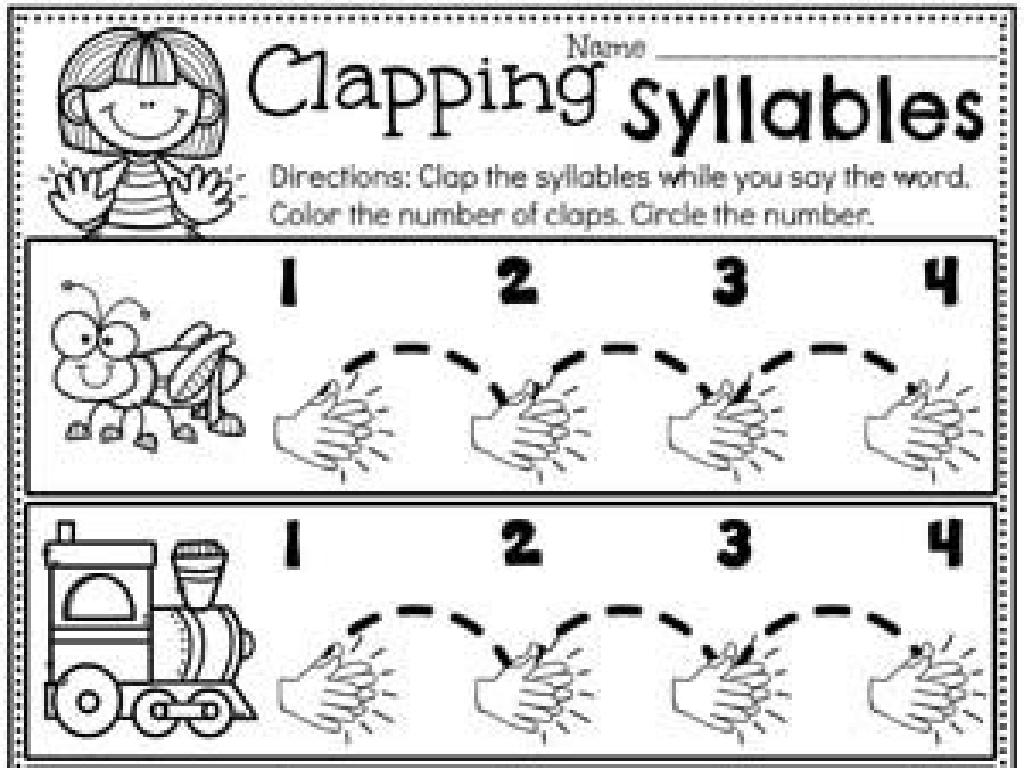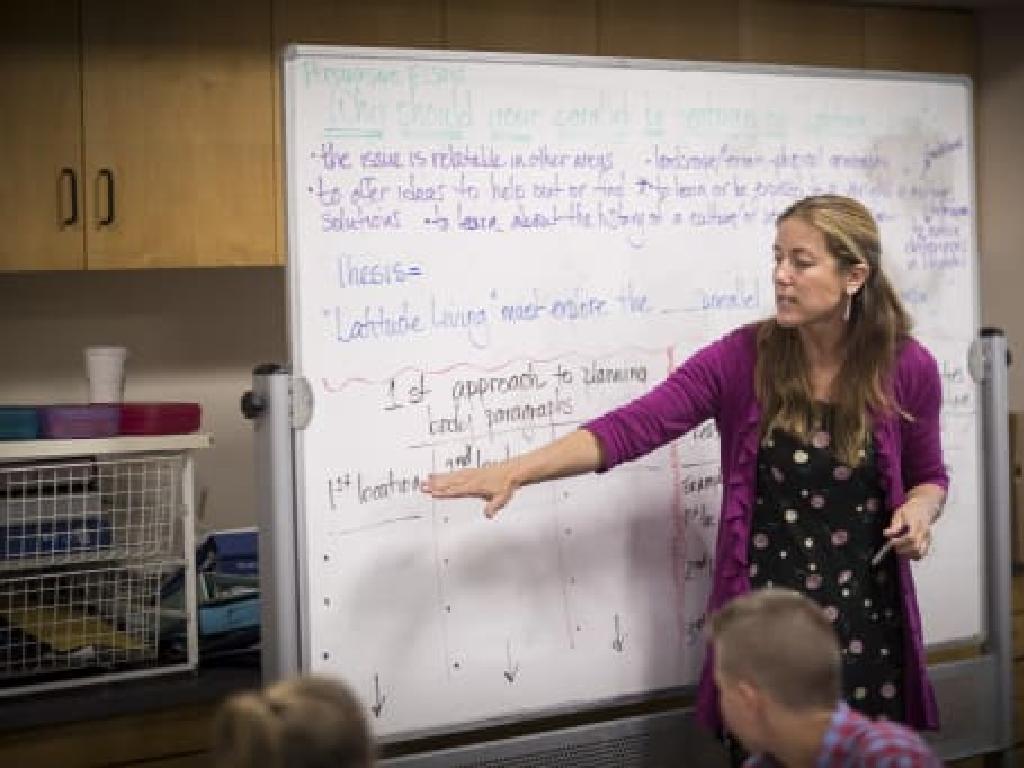Divide Unit Fractions And Whole Numbers Using Area Models
Subject: Math
Grade: Fifth grade
Topic: Understand Fraction Division
Please LOG IN to download the presentation. Access is available to registered users only.
View More Content
Welcome to Fraction Division!
– Understanding fraction division
– Today’s goal: Divide fractions/whole numbers
– Learn to divide a unit fraction by a whole number and a whole number by a unit fraction
– Real-life applications
– Use in cooking, dividing pizza, or splitting bills
– Practice with area models
– Visualize division using shaded parts of rectangles
|
This slide introduces the concept of fraction division to fifth graders, setting the stage for the day’s lesson. The goal is to ensure students understand how to divide unit fractions by whole numbers and whole numbers by unit fractions. Emphasize real-life applications such as cooking, where recipes might need to be halved or quartered, or in dividing a pizza among friends to make the concept relatable. Use area models to provide a visual representation of the division process, which can help students grasp the concept more concretely. Encourage students to think of other areas where they might need to divide things into parts. The slide should be interactive, with examples that students can solve using area models.
Understanding Unit Fractions
– Define a unit fraction
– A fraction with a numerator of 1
– Examples: 1/2, 1/3, 1/4
– Simplest pieces of a whole, like a single slice of a pie
– Building fractions from units
– Every fraction is a sum of unit fractions
– Visualizing with area models
– Draw a rectangle, divide it into equal parts, shade one to represent a unit fraction
|
Begin the lesson by defining a unit fraction as a fraction where the numerator is one and the denominator is a whole number. Provide examples of unit fractions such as 1/2, 1/3, and 1/4 to illustrate the concept. Explain that all fractions are composed of unit fractions, which helps in understanding how fractions can be added or subtracted. Use area models to visually demonstrate unit fractions by drawing a rectangle, dividing it into equal parts, and shading one part to represent a unit fraction. This visual representation will aid students in grasping the concept of unit fractions as building blocks for other fractions.
Understanding Whole Numbers and Fractions
– Define whole numbers
– Numbers without fractions or decimals: 0, 1, 2, 3…
– Examples of whole numbers
– Counting numbers like 1, 2, 3, 4 are whole numbers
– Combining whole numbers and fractions
– Use area models to show fractions with whole numbers
– Visualizing with area models
|
This slide introduces students to the concept of whole numbers and how they relate to fractions, setting the stage for understanding division involving both. Whole numbers are the basic counting numbers starting from 0 and increasing by 1. Provide clear examples of whole numbers to ensure understanding. Then, explain how whole numbers can be combined with fractions, using area models to represent this visually. Area models will help students grasp the concept of dividing unit fractions by whole numbers, which will be covered in subsequent lessons. Encourage students to think of whole numbers as ‘whole pieces’ and fractions as ‘parts of a piece’ to aid in visualizing the combination of the two.
Dividing Unit Fractions by Whole Numbers
– Divide a unit fraction by a whole number
– A unit fraction has a numerator of 1. To divide by a whole number, imagine splitting the fraction into that many equal parts.
– Use area models for visual help
– Area models show the fraction as a shape divided into equal parts. Each part represents a piece of the whole.
– Example: Divide 1/3 by 2
– Split 1/3 into 2 equal sections. Each section is 1/6. So, 1/3 ÷ 2 = 1/6.
|
This slide introduces the concept of dividing unit fractions by whole numbers, which is a key component of understanding fraction division. Start by explaining what a unit fraction is and how division is essentially splitting it into smaller, equal parts. Use area models to visually represent the process, as this can be particularly helpful for fifth graders to understand the concept. Walk through the step-by-step example of dividing 1/3 by 2, showing how the area model is divided and how each section represents a part of the whole. This concrete example will help solidify the students’ understanding. Encourage students to draw their own area models and practice with different unit fractions and whole numbers.
Dividing Whole Numbers by Unit Fractions
– Dividing by a unit fraction
– To divide by a unit fraction, invert and multiply.
– Area models explain division
– Area models visually represent division as equal parts.
– Step-by-step: Divide 5 by 1/2
– Example: 5 ÷ 1/2 equals 5 times 2, which is 10.
|
This slide introduces the concept of dividing whole numbers by unit fractions. Start by explaining that dividing by a unit fraction is the same as multiplying by its reciprocal. Use area models to visually demonstrate how division can be represented by dividing a shape into equal parts. For the step-by-step example, show how dividing 5 by 1/2 can be solved by multiplying 5 by 2 (the reciprocal of 1/2), resulting in 10. Emphasize that the area model helps students visualize the process. Encourage students to draw their own area models for practice and provide additional examples for them to solve.
Fraction Division Practice
– Solve 1/4 ÷ 3 using area model
– Visualize 1/4 split into 3 equal parts
– Divide 6 ÷ 1/6 with area model
– How many 1/6s fit into 6? Use area model to see
|
This slide is aimed at providing students with practice problems to apply their understanding of dividing unit fractions by whole numbers and vice versa using area models. For the first example, guide students to visualize an area model representing 1/4 and then dividing that area into 3 equal parts to find the result. For the second example, instruct students to draw an area model for the whole number 6 and then partition it into sections representing 1/6 to determine how many sixths make up the whole. Encourage students to discuss their thought process and reasoning as they work through these problems. Provide additional similar problems for students who finish early or need extra practice.
Class Activity: Fraction Division with Area Models
– Create area models for fraction division
– Pair up for problem-solving
– Discuss solutions with your partner
– How did your answers compare?
– Present your findings to the class
– Explain your model and reasoning
|
This activity is designed to help students visualize the concept of dividing unit fractions by whole numbers using area models. Students should work in pairs to encourage collaboration and discussion, which can lead to a deeper understanding of the material. As they create their area models, they should divide the model into sections that represent the whole number and then shade in the fraction that is being divided. After solving the problems, they should compare their solutions with their partner to see if they arrived at the same answer and discuss any discrepancies. Finally, each pair will present their area model to the class, explaining their approach and reasoning. This will help reinforce their understanding and allow for peer learning. Possible activities could include dividing 1/2 by 2, 1/4 by 4, or 1/8 by 8, using grid paper to create the area models.
Wrapping Up: Fractions and Homework
– Review of fraction division
– Significance of mastering this skill
– Grasping fraction division is crucial for advanced math topics.
– Homework: Fraction worksheet
– Solve problems on dividing unit fractions by whole numbers.
– Practice makes perfect!
|
As we conclude today’s lesson, it’s important to recap the concept of dividing unit fractions by whole numbers using area models. Emphasize the importance of understanding fraction division as it is a foundational skill that will be used in future math concepts. For homework, students are assigned a worksheet that includes a variety of problems to reinforce their learning. Encourage them to practice diligently, as consistent practice is key to mastering fraction division. Be prepared to review the homework at the beginning of the next class and address any questions or difficulties the students may have encountered.





